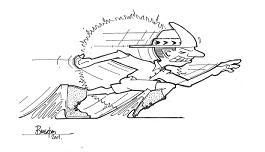Hi Blitz,
Here is some info you may like to see.
Not my own work, but good info.
You may want to take after market cool tins and flaten them, copy the shape onto a sheet of copper, cut out to shape, bend, and fit, this is the best you can do. AND look at the shape of your side fins.
""""""""Type 3 Air Deflector (Cool Tin) Installation
by Ron Van Ness
August 11, 1999
When I was deciding on the best parts to use on my relatively stock 1600 engine, I heard that the air deflector tinware found stock on VW Type 3 engines would keep the cylinders cooler. The stock Type 1 engine air deflectors clip on the head studs between the cylinders, diverting the downward flow of cooling air from the fan shroud across the cylinder fins (without any deflectors, the engine would overheat very quickly, hence all the dire warnings in the service manuals!). The Type 3 air deflectors (or "Cool Tin" as they are called by aftermarket parts suppliers) surround the lower half of the cylinders to provide better, more even circulation of cooling air. Because of the relatively more restricted engine compartment design of the Type 3, such tinware innovation was necessary to keep the engine temperatures down. Such air deflectors are also similar in design to those found on the larger displacement Type IV bus engines. Here's a photo of the Type 3 tin being installed:
When shopping for "Cool Tin" I found that the aftermarket tin, though appearing like the original Type 3 tin, was made from thinner gauge sheet metal and was less rigid than I hoped. I bought a pair of used OEM VW Type 3 tin (pictured) from Volks-motorsports that I found to be of better quality.
A problem often cited when using Type 3 air deflectors is that they tend to pop off the studs, falling away from the cylinders, defeating their purpose. To avoid this, secure the tin via wires or rods through the center wedge, and tie these to the upper studs to keep the tin securely against the cylinders, as Bob Hoover outlines in his Sermons CD. I accomplished this with two stainless steel wires as pictured below:
My installation also included some additional stainless wires laced through tiny holes I drilled on the outboard clips that grip the deflectors to the studs. With the cylinders and tin in place, I twisted this wire so that the clips were forced against the studs, then cut off the excess wire. In retrospect, I think these additional wires were overkill. If you install this tinware, only the center wires are necessary.
Installation of the Type 3 air deflector tin requires clearancing the lower tinware that protects the pushrod tubes and serves as a plenum to discard the heated air. Clearancing entails hammering out the section of tin that conflicts with the bulges in the Type 3 deflector while maintaining a snug fit between the tin when the pieces are assembled.
After over 25,000 miles on the rebuild I can comment on temperatures, but due to confounding variables, I don't have enough data to indicate how much or if my engine has benefited from the Type 3 air deflectors. My engine tends to run hot, and I see a consistent maximum of 350 degrees on the cylinder head temperature gauge during highway runs, with a maximum oil temperature of around 240 on 90 degree days, traveling for 1/2 hour+ on the highway at 63-65 mph. With my auxiliary oil cooler I've reduced the oil temperature some, but the CHT remains the same. This is with a 7:1 compression ratio.
Recently I experimented by removing the cylinders shims to raise the CR near the 8:1 mark, noting how much higher the temperatures reached and if there would be a power increase. After retarding the timing and switching to premium to avoid pinging, I'm now seeing a max. CHT of 400-425 degrees (a 50-75 deg. increase) with a corresponding increase in oil temperature of 10 degrees. Clearly, either with a 7:1 or 8:1 CR, the bus is running too hot. I've not yet experimented measuring temperatures after swapping the Type 3 air deflectors for the stock Type 1 deflectors, so I can't assess how much advantage there is to using the Type 3 tin.
On an interesting side note, with the CR of 7:1 even if I added timing advance and ran regular gas, I never heard pinging, but with the 8:1 of course, it's imperative to retard the timing. After factoring in the timing retard and premium gas, there was absolutely no net gain in power by going to the 8:1 CR, measured by the tried and true "seat of pants" method. Conclusion: Whatever minute power gains if any that can be made by raising CR are not worth it. CC your heads, install those CR shims and keep the temperatures and gas bills down! """"""""
Hope it helps



